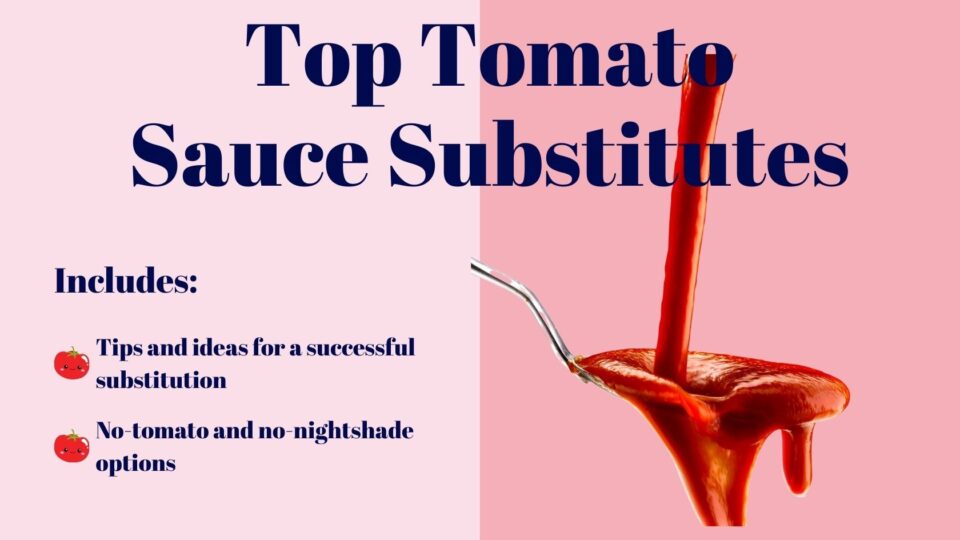Getting hold of useful tomato sauce substitutes can be easy if it’s just an ingredient for your recipe. But the difficulty can progress if there’s a need for a tomato sauce substitute without tomatoes, or for that matter, a substitute that’s not from the tomato or nightshade family.
Tomatoes and tomato-based ingredients are quite ubiquitous in many cuisines and recipes. Yet, action and options are necessary where substitution is a must.
The best substitutes for tomato sauce are tomato paste, canned tomatoes, tomato powder (granulated tomato) and tomato puree. The next tier of substitutes for tomato sauce belongs to tomato ketchup, tomato soup, and tomato juice. In some cases, using pizza/pasta sauce and marinara sauce can work.
Substitutes for tomato sauce without tomato include red pepper sauce/paste, pesto, sauces made from carrots, eggplants, and beets, and nomato/fauxmato sauces that avoid any ingredients from the nightshade family.
That’s quite a lot to unpack, so let’s get a more detailed picture.
Table of Contents
Top Substitutes For Tomato Sauce
1. Tomato Paste
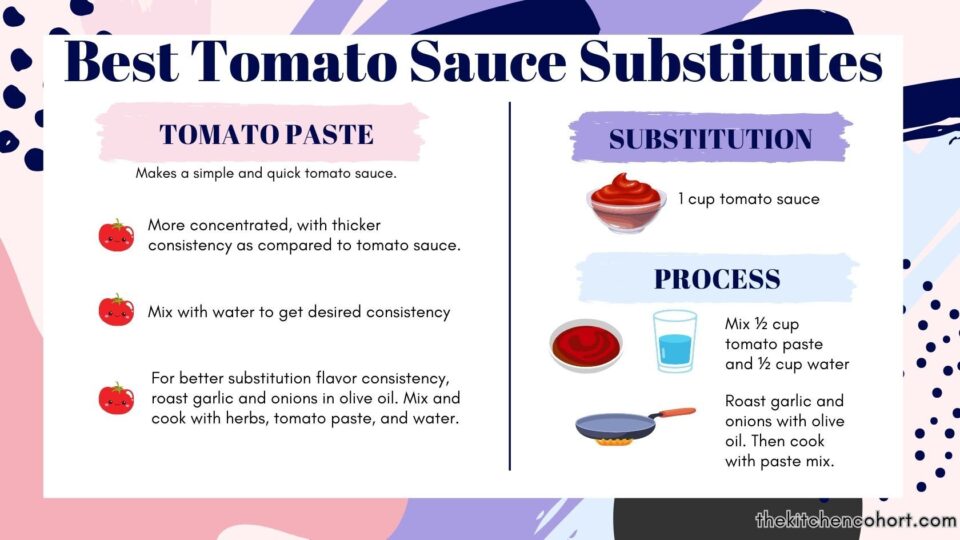
Tomato paste is the easiest and pretty much the most natural substitute for tomato sauce. It’s easy to substitute, with the condition that tomato paste has a much thicker consistency as compared to sauce, so adding some water is necessary.
Simply add equal parts of water and tomato paste, then mix thoroughly. This should be enough to create a consistency very similar to tomato sauce. For example, if a recipe calls for a cup of tomato sauce, adding half (½) cup each of tomato paste and water should do the trick. Add or reduce the water content as necessary to suit your preferences.
While this covers a significant part of the substitution, there is still another step. Tomato sauce usually contains garlic and onions, and some recipes may also use herbs like basil.
Delving into some culinary art should make up for this lack of flavors. Add some olive oil in a pan and use it to roast some finely chopped onions and garlic. Once these turn soft and the garlic smell goes away, add the mix of tomato paste and water. It’s also possible to add the herbs you like at this stage.
Some commercial tomato paste contains salt. Check the label of the product to see if it contains salt, or add salt to taste.
After a few minutes, a quick-fix tomato sauce is ready. It would be okay to remove pieces of garlic and onion from this DIY sauce before using it.
This sauce likely won’t have the same depth of flavors for garlic, onions, and other ingredients as tomato sauce, but it is a close approximation. Obviously, cooking for a long time with herbs and other ingredients gives the classic tomato sauce a more prominent flavor as opposed to cooking for a few minutes (like for this substitute).
Yet, this method is both workable and deliciously suitable for this substitution.
2. Canned Tomatoes
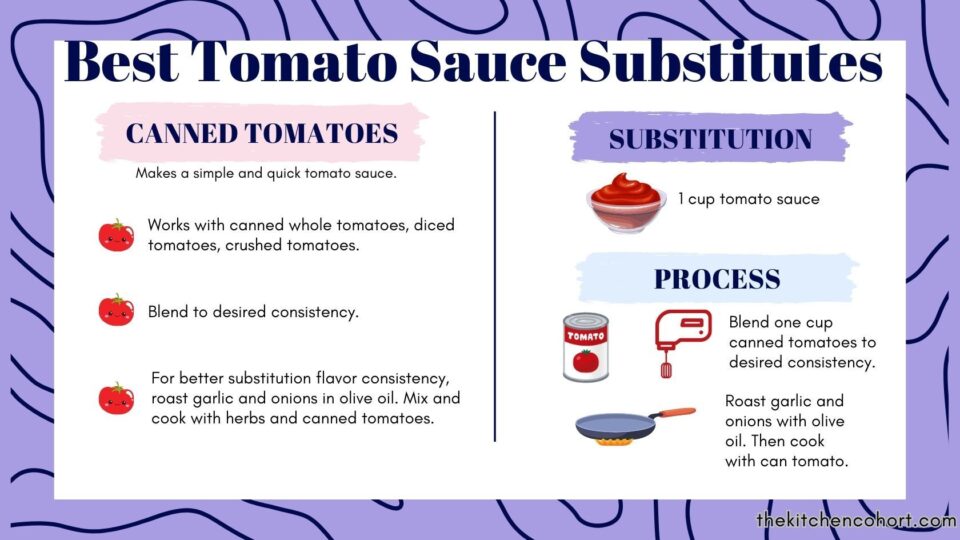
Canned tomatoes provide another simple, quick way to whip up some tomato sauce for use in a recipe. This method can work whether the can contains whole tomatoes, diced tomatoes, or crushed tomatoes.
Canned tomatoes contain a lot of liquid, so you may want to drain that liquid to another container. When using diced or crushed tomatoes, just scoop out the necessary amount.
Blend the tomatoes until you have the right consistency. If the canned tomatoes appear to be too watery, it’s acceptable to put them on heat and reduce them until the right consistency is achieved. If it’s too thick, adding some liquid from the can or water can work too.
While canned tomatoes contain some salt, they won’t have the garlic or onion ingredients common in tomato sauce. For closer substitution, add some olive oil in a pan. When the oil is hot enough, add finely chopped onions and garlic, and roast the mix. As these ingredients roast and the garlic smell goes away, add the blended canned tomatoes to the pan. If some herbs are intended for the recipe, they can be added at this time.
Let the mix cook for a few minutes, then remove it from heat. Depending on your texture preferences, it’s acceptable to remove bits of onions and garlic from the sauce, or crush them into the sauce for a richer flavor.
And there you have it. A perfect, little tomato sauce substitute whipped up from canned tomatoes, all in a few minutes.
3. Tomato Powder (Granulated Tomato)
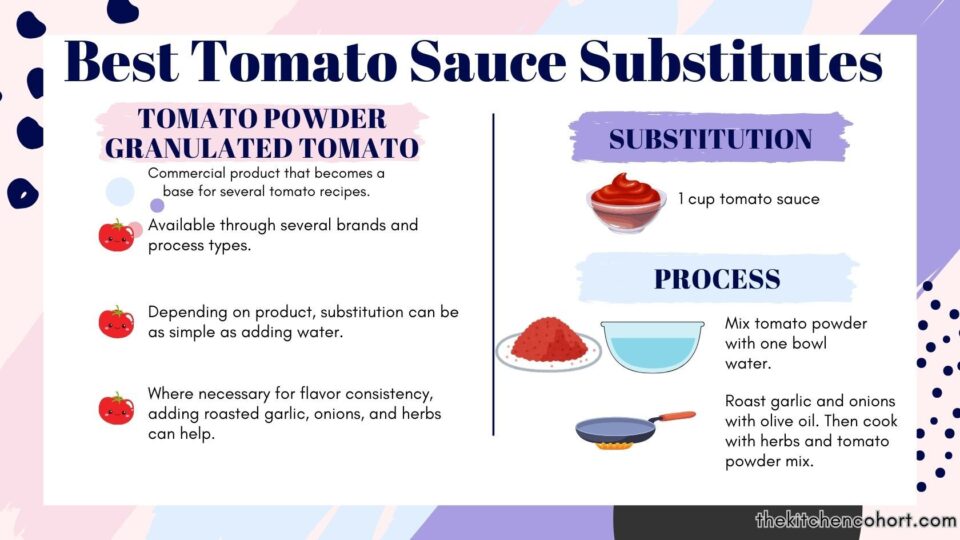
Tomato powder and granulated tomato are commercial products. They’ve gained quite some fame and popularity in recent years and are increasingly popular for their use in recipes as tomatoes or for tomato-based ingredients and condiments.
Since this is a commercial product offered by various brands using different types of methods, the exact way for them to work as tomato sauce substitutes can vary. Some brands may actually use dried, powdered tomatoes. While other brands may go with freeze drying, spray drying, or other methods.
Irrespective of all that, tomato powder forms a lovely alternative to tomato products like tomato sauce.
In many cases, the substitution can be as simple as adding water to the powder!
Tomato powder or granulated tomato makes for an amazing starter ingredient in most most culinary uses for tomato, including for popular options like tomato sauce, paste, ketchup, and so on.
In case the tomato powder doesn’t contain additional ingredients, you can add some roasted garlic, onion, and herbs to the mix using the recipe described in points for tomato paste and canned tomatoes.
4. Tomato Puree

In a crude sense, commercial tomato puree is a thicker and more aggressively flavored version of tomato sauce. So, getting tomato sauce from tomato puree should be as easy as adding some water.
For example, if the recipe calls for one cup of tomato sauce a workable substitution could be ¾ cup of puree blended with ¼ cup of water.
Of course, it is possible to change the ratio depending on your preferences for taste and consistency.
5. Tomato Ketchup
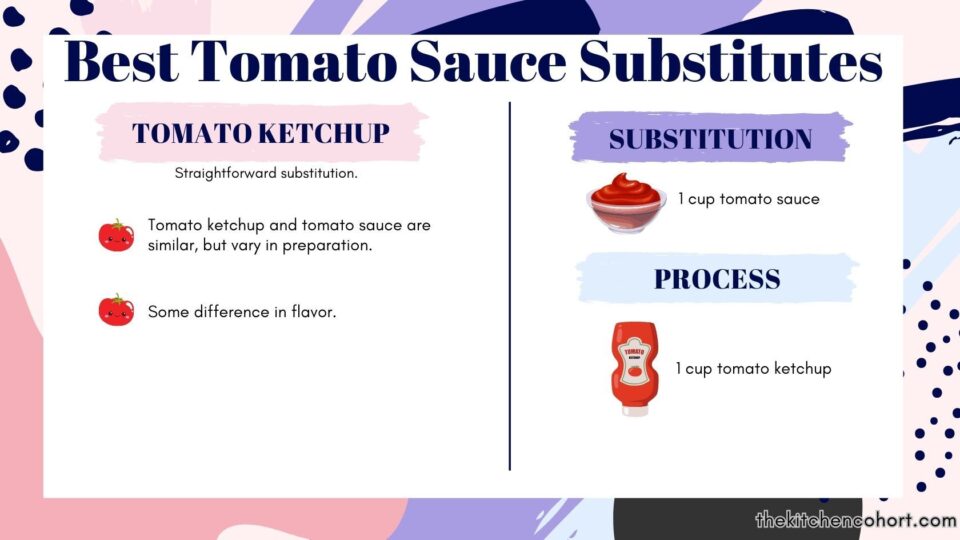
This famed condiment can often work as a workable substitute for tomato sauce. It is not an ideal choice, since tomato ketchup has a different flavor profile due to the presence of vinegar, but it can work if you’re in a tight spot.
Commercial ketchup can also be much sweeter, so that’s something to consider when using this as a substitute. It is usually better to look for a ketchup that has no added sugar – not just for substitution, but also regular consumption.
In most cases, the substitution can work in an equal ratio, that is, adding one part of tomato ketchup for one part of tomato sauce.
6. Tomato Soup (Canned)
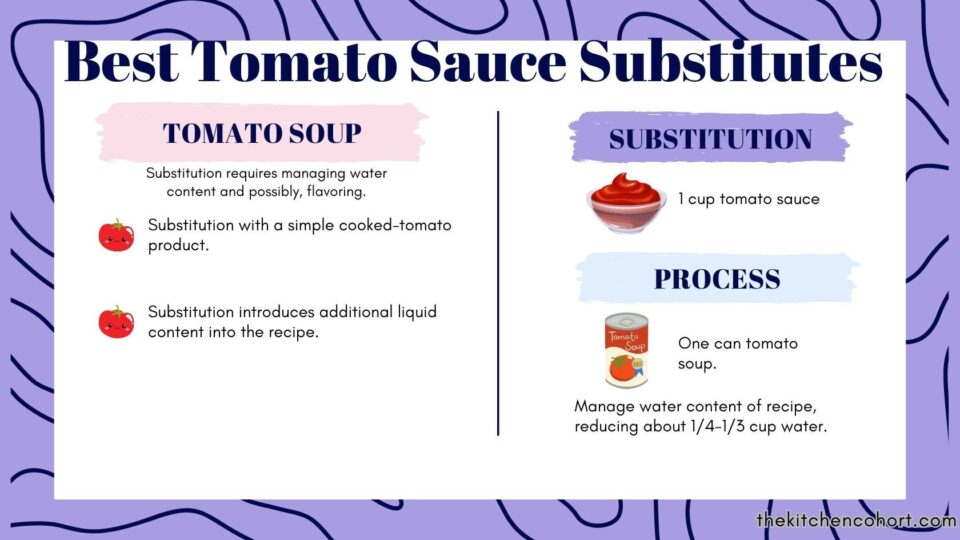
Canned tomato soup can count as a workable tomato sauce substitute. One can of tomato soup can be an acceptable alternative for a cup of tomato sauce.
However, there are considerations here. There is a notable difference in the taste of tomato soup versus tomato sauce. Plus, adding a can of tomato soup introduces additional liquid in the recipe that will need to be accounted for.
To make up for the additional liquid, it’s best to reduce other liquid content in the recipe. Additional flavor adjustments might be necessary to make up for the differences in taste and sweetness.
7. Marinara Sauce
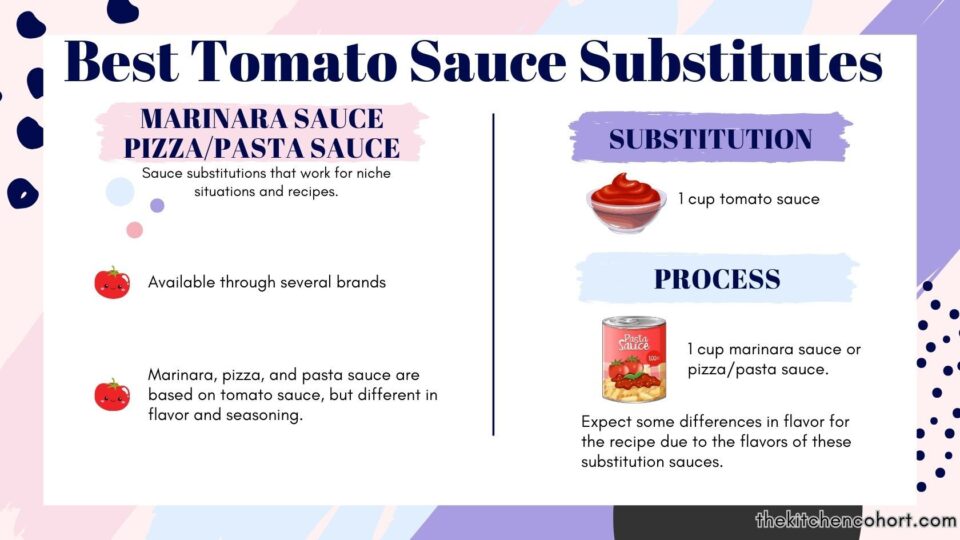
For many home uses, marinara sauce is basically a slightly thicker, more intensely flavored version of tomato sauce. As such, marinara sauce also works as a suitable substitute for tomato sauce.
However, things can change with store-bought versions of marinara sauce, since commercial products are more likely to have other ingredients, and be notably sweeter than homemade marinara. Therefore, some adjustments would be necessary to account for the sweetness and additional ingredients.
8. Pizza/Pasta Sauce
Pizza sauce and pasta sauce are popular tomato-based sauces that are used in several recipes. They can also work as tomato sauce substitutes in some niche recipes. This is because these sauces are significantly more flavorful than tomato sauce, therefore their use warrants adjustments in the recipe.
No-Tomato Alternatives And Substitutes For Tomato Sauce (Including No-Nightshade Options)
1. Pesto (No-Tomato, No-Nightshade Alternative)
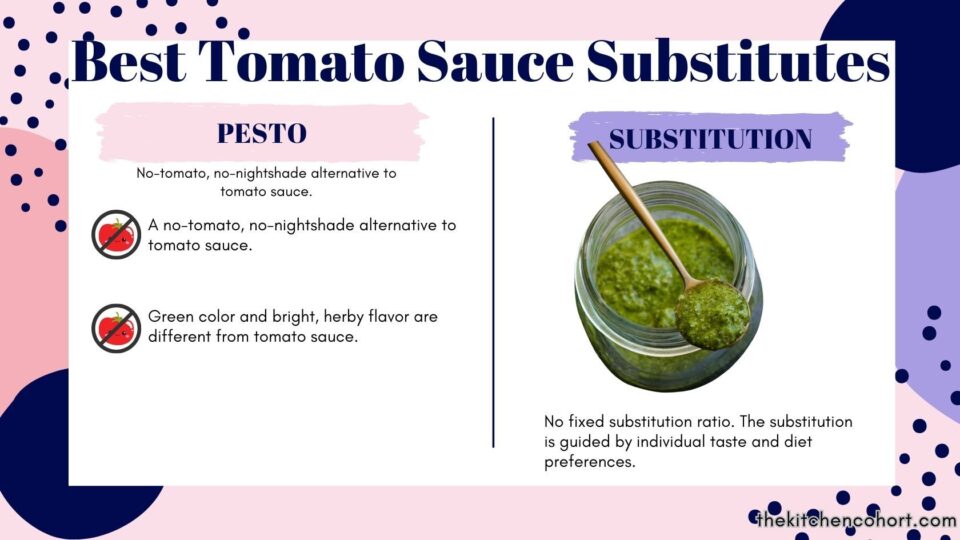
Pesto is an unusual, yet wonderfully capable alternative to tomato sauce in several recipes. The fresh, herbaceous flavor and the usual green color of pesto can seem at odds with the red of tomato sauce. And that stands true for a lot of culinary applications.
But if you want to avoid tomatoes and other fruits/vegetables from the nightshade family, pesto is the easiest available alternative. The nightshade family includes several popular vegetables like tomato, eggplant, potatoes, and peppers. Skipping them all leaves a rather thin room for suitable tomato sauce alternatives.
That said, pesto is a delicious sauce and ingredient in its own right. It also tends to work well with many popular recipes, including pizza.
What could be the most noticeable missing element for such a substitution is the umami flavor that tomatoes bring to the plate and the palate. Tomatoes are loaded with glutamates, which would be missing in a usual pesto. If this is a sticking problem for the recipe, adding other ingredients with umami flavor could help bring back some balance.
There is no fixed or suggestible ratio for substituting pesto for tomato sauce. Working with some culinary skills and taste preferences is the way forward for this alternative.
2. Nomato Sauce/Fauxmato Sauce (No-Tomato Option, No-Nightshade Variants)
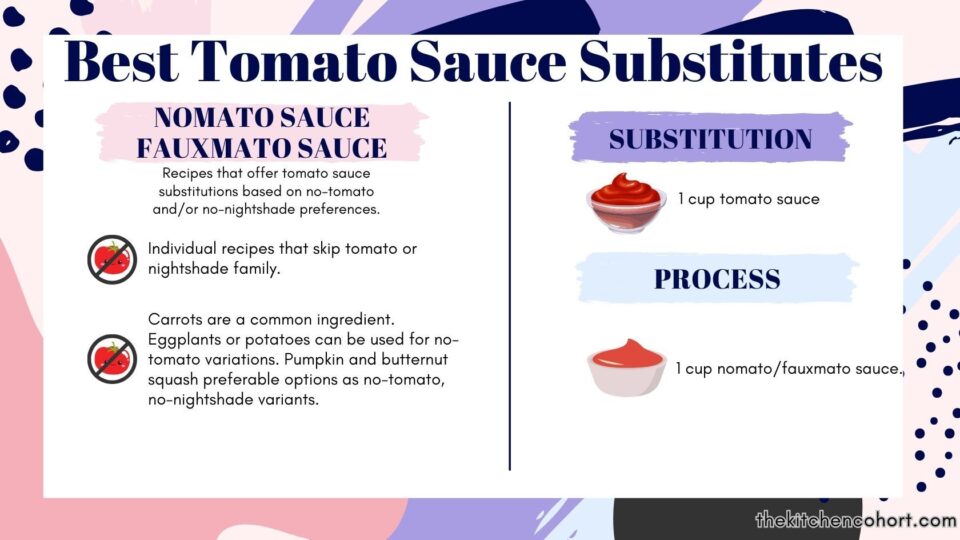
To be clear, “nomato” is not a well-defined term for actual culinary use. It is, however, a popularly used colloquialism, usually intended to represent a recipe (like tomato sauce) where tomatoes have been removed or replaced. Fauxmato sauce (faux-tomato sauce) as a term serves pretty much the same purpose.
A recipe to this effect usually involves replacing tomatoes with suitable ingredients. Basic variations that don’t shy away from nightshades can include carrots and eggplants to add substance to the sauce. Sometimes potatoes come into play as well to provide volume to the sauce.
An advantage of this approach is that the sauce can be more neutral tasting. Obviously, it still doesn’t taste like tomato, but it doesn’t push the recipe in the direction of other flavors either.
Variations that avoid nightshades are somewhat more popular in this category, relying on carrots and similar ingredients.
Just like tomato sauce, there can be many variations of the nomato sauce recipe. It can be as simple as using plain carrots with the basic ingredients. Or, you can make it a bit more complex and flavorful with additional ingredients like this nomato sauce recipe.
Many of the nomato/fauxmato sauce recipes tend to use beets as a way to bring a rich red color to the recipe. I usually find that working with beets solely for coloring isn’t as satisfying and fruitful as hoped. They can make the sauce rather easy to lean into an earthy taste, which isn’t often desirable for a tomato sauce replacement.
Add to that their questionable performance at high heat (where coloring is concerned) and you’ve got a case against using beets for several recipes. I’m more comfortable with red food coloring for this purpose, though of course, that has its own share of controversies and downsides.
Pumpkin puree or diced pumpkins are another favorite for making a nomato sauce that also goes nightshade-free. I like this option better as pumpkin tends to provide a texture more similar to tomato sauce. Plus, it tends to be on the slightly sweet but neutral side of the taste spectrum, making it more suitable for a tomato sauce substitute.
While pumpkins shine in such a recipe, most recipes include carrots as well, along with beets if you want the color.
Butternut squash is also a useful ingredient (to use in place of pumpkin) for similar results. The fauxmato sauce cooking process is quite similar to classic tomato sauce, as described in this recipe.
Many recipes tend to use zucchini as well, which works rather deliciously well too.
Given the variations in this type of recipe, those using a store-bought/commercial option should make it a point to check the ingredients list to ensure that the product (and its ingredients) are suitable for their taste and diet requirements.
3. Ajvar (No-Tomato Option)
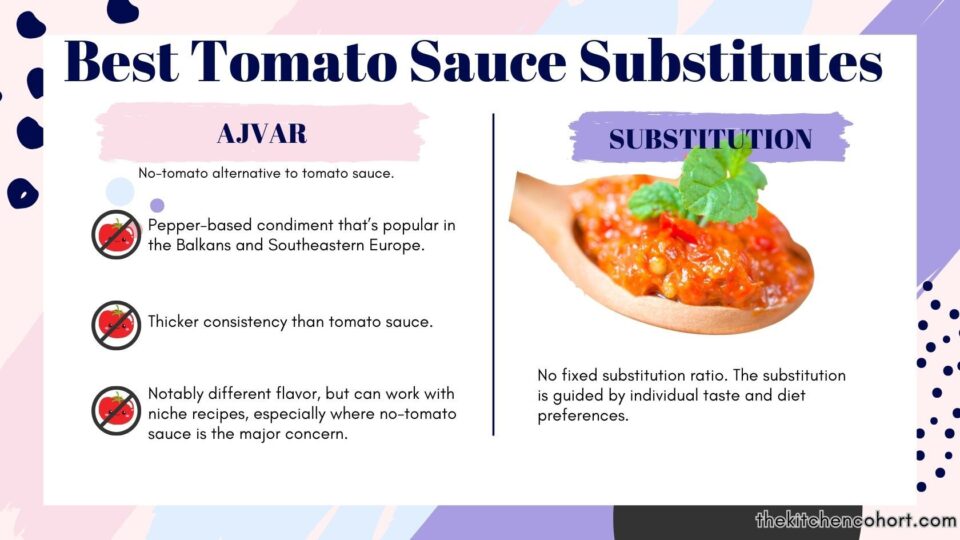
Ajvar is a bell-pepper based paste that’s fairly popular in the Balkans and Southeastern Europe. Since the recipe is generally based-off bell peppers, this is a tomato-free option, but not a nightshade-free option.
In most countries outside of its home region, ajvar is usually sold as a commercial product and might be considered a specialty item.
It has a consistency somewhat more in line with tomato paste and can be similar to a spread. Depending on the types of pepper used and the recipe, ajvar may have a mild to piquant heat and spiciness.
As is apparent, the recipe is fairly different from tomato sauce. But it can be a workable tomato sauce substitute for some recipes, provided you know your way around handling and cooking this condiment. It does work rather deliciously well on pizza and some similar applications, so its use as a tomato sauce alternative is viable.
It’s worth noting that ajvar recipes can have significant variations, including varieties that include tomatoes. As such, it’s best to check the ingredient list when purchasing this product.
4. Bell Pepper Puree/Sauce (No-Tomato Option)

Red bell peppers seem almost like the natural alternative when you want tomato sauce substitutes that are as vibrant and flavorful. And with the right capsaicin flavor, they bring that nice touch to the sauce that makes them all the more alluring. There’s also a touch of smoky and earthy flavor, considering the bell peppers are roasted for this puree and sauce.
At this point, it’s worth noting that bell peppers belong to the nightshade family, so this option is tomato-free, not nightshade-free.
While bell pepper sauce can be made at home, most people choose to buy commercial offerings. In such cases, do remember to read the list of ingredients before buying to ensure it suits your purpose.
Best Tomato Sauce Substitutes – Making The Choice
With that well-structured and in-depth article on substituting for tomato sauce, it becomes possible to ascertain some key aspects.
It’s worth noting that tomatoes are unique enough and basic ingredients that are not so easily replaced.
As we see, many close-enough alternatives to tomato sauce do involve tomatoes in the lead role. Additionally, a good chunk of the substitutes for tomato sauce actually provide a simple way to whip up a small batch of the sauce for use in a recipe. Tomato puree, powder, canned tomatoes, and tomato paste are relevant examples. While additional alternatives do exist, this seems to be the way that gets best results.
Some variations are available to those who would like to avoid tomatoes or the nightshade family altogether, whether due to medical, sensitivity, or any other reasons. However, as we all know, tomatoes are almost ubiquitous in several recipes and can be difficult to completely cut-off. Hence, it is a good thing that these alternatives get creative towards getting the right elements for substituting tomato sauce, while still keeping important culinary characteristics.
One of the more notable changes with non-tomato options can be the missing umami flavor that tomatoes bring to food. Accounting for that with additional ingredients can make the substitution of tomato sauce with no-tomato options feel more fulfilling.

